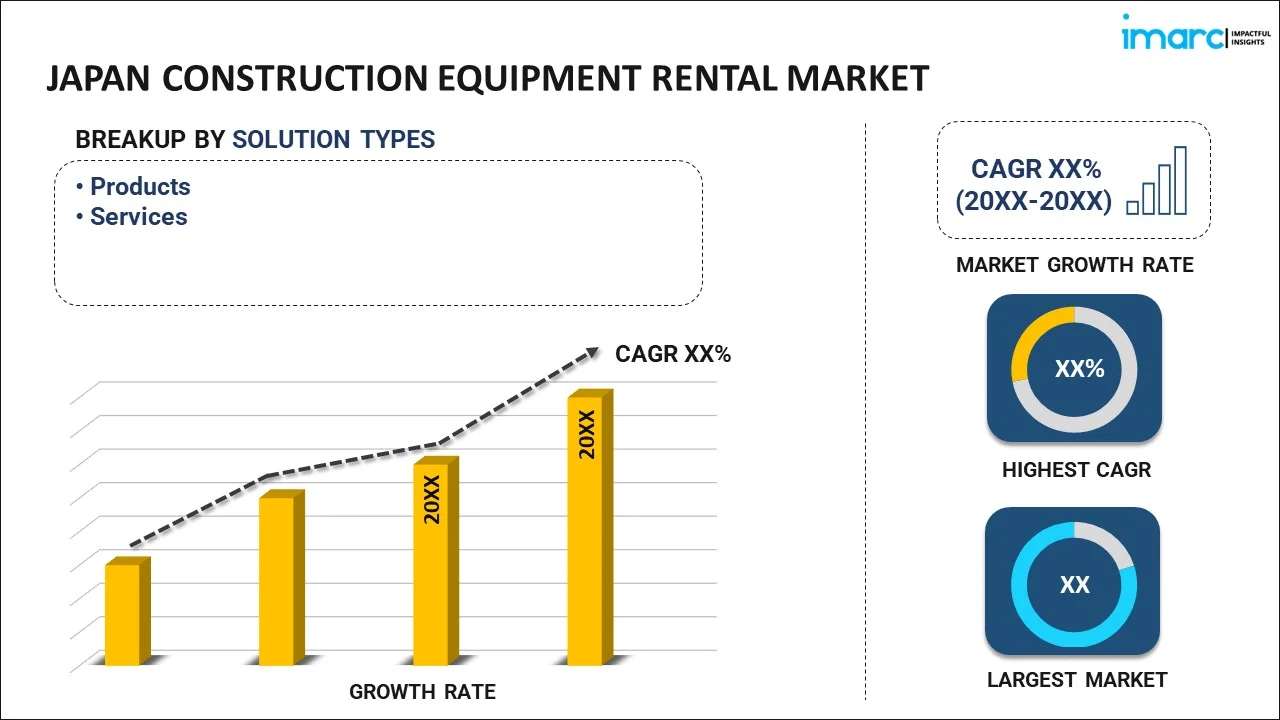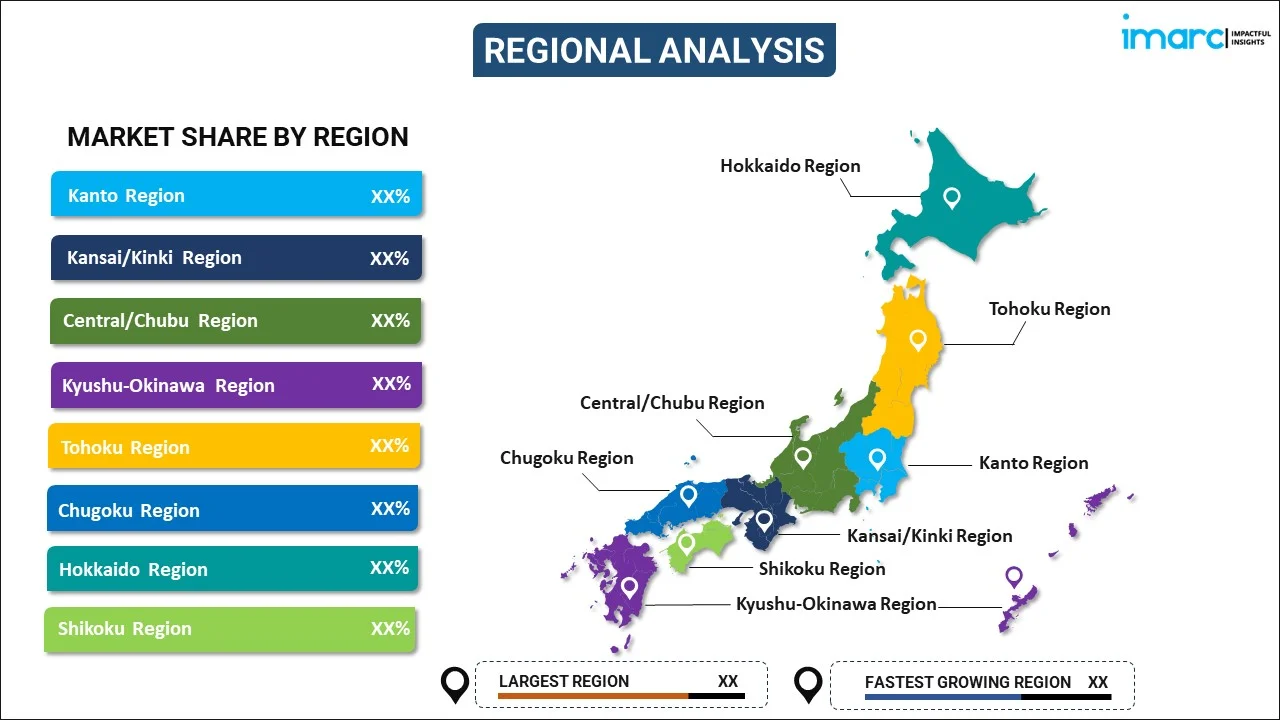
Japan Construction Equipment Rental Market Report by Solution Type (Products, Services), Equipment Type (Heavy Construction Equipment, Compact Construction Equipment), Type (Loader, Cranes, Forklift, Excavator, Dozers, and Others), Application (Excavation and Mining, Lifting and Material Handling, Earth Moving, Transportation, and Others), Industry (Oil and Gas, Construction and Infrastructure, Manufacturing, Mining, and Others), and Region 2025-2033
Market Overview:
Japan construction equipment rental market size reached USD 11.4 Billion in 2024. Looking forward, IMARC Group expects the market to reach USD 19.9 Billion by 2033, exhibiting a growth rate (CAGR) of 6.08% during 2025-2033. The inflating popularity of rental and leasing services and the growing advancements in the industrialization activities represent some of the key factors driving the market growth in the country.
|
Report Attribute
|
Key Statistics
|
|---|---|
|
Base Year
|
2024
|
|
Forecast Years
|
2025-2033
|
|
Historical Years
|
2019-2024
|
|
Market Size in 2024
|
USD 11.4 Billion |
|
Market Forecast in 2033
|
USD 19.9 Billion |
| Market Growth Rate 2025-2033 | 6.08% |
Construction machinery comprises large-scale, purpose-built machines designed specifically for the execution of construction tasks. This category encompasses a variety of equipment, including excavators, bulldozers, backhoes, concrete mixers, cranes, and loaders. Manufactured from durable materials like steel and heavy-duty plastics, these machines are engineered to withstand demanding conditions. The utilization of construction equipment spans a wide range of applications, such as building roads, erecting skyscrapers, tunnel excavation, pipeline installation, bridge construction, mine excavation, landfill operations, agricultural activities, structure demolition, and dam construction. The deployment of construction machinery brings numerous advantages, including increased efficiency, reduced manual labor, accelerated construction speed, enhanced safety measures, lowered overall project costs, and heightened operational scalability.
Japan Construction Equipment Rental Market Trends:
The escalating labor costs have led businesses to invest in construction equipment to mitigate reliance on manual labor, decrease operational expenses, and expedite project timelines, fostering growth in the construction equipment rental market in Japan. Moreover, the advent of rental and leasing services has notably improved equipment accessibility, especially for small and medium-sized enterprises (SMEs), allowing them to benefit without substantial upfront investments, which is positively influencing the regional market. Additionally, the increasing engagement of the private sector in infrastructure development, particularly through public-private partnership (PPP) projects, is a key driver for market expansion. Furthermore, the renewable energy sector is witnessing extensive equipment utilization for the construction of wind farms, solar parks, and related facilities, contributing significantly to market growth. The incorporation of advanced machinery with safety features, including collision detection and avoidance systems based on artificial intelligence (AI), is also playing a pivotal role in market expansion. Government bodies across Japan are recognizing the significance of infrastructure development for their country' economic prosperity and are therefore channeling substantial investments into such projects. Moreover, the application of construction equipment in mining operations for the excavation of minerals, metals, and fossils will support the positive trajectory of the market over the forecasted period.
Japan Construction Equipment Rental Market Segmentation:
IMARC Group provides an analysis of the key trends in each segment of the market, along with forecasts at the country level for 2025-2033. Our report has categorized the market based on solution type, equipment type, type, application, and industry.
Solution Type Insights:

- Products
- Services
The report has provided a detailed breakup and analysis of the market based on the solution type. This includes products and services.
Equipment Type Insights:
- Heavy Construction Equipment
- Compact Construction Equipment
A detailed breakup and analysis of the market based on the equipment type have also been provided in the report. This includes heavy construction equipment and compact construction equipment.
Type Insights:
- Loader
- Cranes
- Forklift
- Excavator
- Dozers
- Others
The report has provided a detailed breakup and analysis of the market based on the type. This includes loader, cranes, forklift, excavator, dozers, and others.
Application Insights:
- Excavation and Mining
- Lifting and Material Handling
- Earth Moving
- Transportation
- Others
A detailed breakup and analysis of the market based on the application have also been provided in the report. This includes excavation and mining, lifting and material handling, earth moving, transportation, and others.
Industry Insights:
- Oil and Gas
- Construction and Infrastructure
- Manufacturing
- Mining
- Others
The report has provided a detailed breakup and analysis of the market based on the industry. This includes oil and gas, construction and infrastructure, manufacturing, mining, and others.
Regional Insights:

- Kanto Region
- Kansai/Kinki Region
- Central/ Chubu Region
- Kyushu-Okinawa Region
- Tohoku Region
- Chugoku Region
- Hokkaido Region
- Shikoku Region
The report has also provided a comprehensive analysis of all the major regional markets, which include Kanto Region, Kansai/Kinki Region, Central/ Chubu Region, Kyushu-Okinawa Region, Tohoku Region, Chugoku Region, Hokkaido Region, and Shikoku Region.
Competitive Landscape:
The market research report has also provided a comprehensive analysis of the competitive landscape. Competitive analysis such as market structure, key player positioning, top winning strategies, competitive dashboard, and company evaluation quadrant has been covered in the report. Also, detailed profiles of all major companies have been provided.
Japan Construction Equipment Rental Market Report Coverage:
| Report Features | Details |
|---|---|
| Base Year of the Analysis | 2024 |
| Historical Period | 2019-2024 |
| Forecast Period | 2025-2033 |
| Units | Billion USD |
| Scope of the Report | Exploration of Historical and Forecast Trends, Industry Catalysts and Challenges, Segment-Wise Historical and Predictive Market Assessment:
|
| Solution Types Covered | Products, Services |
| Equipment Types Covered | Heavy Construction Equipment, Compact Construction Equipment |
| Types Covered | Loader, Cranes, Forklift, Excavator, Dozers, Others |
| Applications Covered | Excavation and Mining, Lifting and Material Handling, Earth Moving, Transportation, Others |
| Industries Covered | Oil and Gas, Construction and Infrastructure, Manufacturing, Mining, Others |
| Regions Covered | Kanto Region, Kansai/Kinki Region, Central/ Chubu Region, Kyushu-Okinawa Region, Tohoku Region, Chugoku Region, Hokkaido Region, Shikoku Region |
| Customization Scope | 10% Free Customization |
| Post-Sale Analyst Support | 10-12 Weeks |
| Delivery Format | PDF and Excel through Email (We can also provide the editable version of the report in PPT/Word format on special request) |
Key Questions Answered in This Report:
- How has the Japan construction equipment rental market performed so far and how will it perform in the coming years?
- What has been the impact of COVID-19 on the Japan construction equipment rental market?
- What is the breakup of the Japan construction equipment rental market on the basis of solution type?
- What is the breakup of the Japan construction equipment rental market on the basis of equipment type?
- What is the breakup of the Japan construction equipment rental market on the basis of type?
- What is the breakup of the Japan construction equipment rental market on the basis of application?
- What is the breakup of the Japan construction equipment rental market on the basis of industry?
- What are the various stages in the value chain of the Japan construction equipment rental market?
- What are the key driving factors and challenges in the Japan construction equipment rental?
- What is the structure of the Japan construction equipment rental market and who are the key players?
- What is the degree of competition in the Japan construction equipment rental market?
Key Benefits for Stakeholders:
- IMARC’s industry report offers a comprehensive quantitative analysis of various market segments, historical and current market trends, market forecasts, and dynamics of the Japan construction equipment rental market from 2019-2033.
- The research report provides the latest information on the market drivers, challenges, and opportunities in the Japan construction equipment rental market.
- Porter's five forces analysis assist stakeholders in assessing the impact of new entrants, competitive rivalry, supplier power, buyer power, and the threat of substitution. It helps stakeholders to analyze the level of competition within the Japan construction equipment rental industry and its attractiveness.
- Competitive landscape allows stakeholders to understand their competitive environment and provides an insight into the current positions of key players in the market.
Need more help?
- Speak to our experienced analysts for insights on the current market scenarios.
- Include additional segments and countries to customize the report as per your requirement.
- Gain an unparalleled competitive advantage in your domain by understanding how to utilize the report and positively impacting your operations and revenue.
- For further assistance, please connect with our analysts.
 Inquire Before Buying
Inquire Before Buying
 Speak to an Analyst
Speak to an Analyst
 Request Brochure
Request Brochure
 Request Customization
Request Customization




.webp)




.webp)












